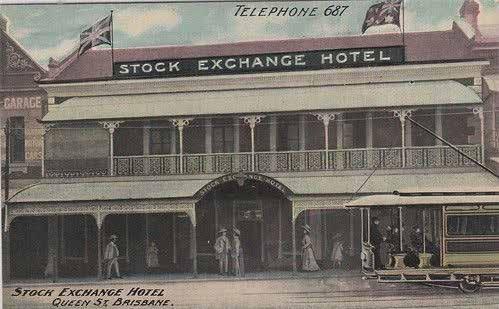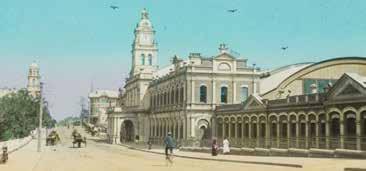
13 minute read
History
ENTERPRISING LADIES
OF EARLY BRIBIE BY LYNNE HOOPER
Advertisement
efore the Brisbane Tug &
BSteamship Company built a store and dining room at the Jetty in 1915, the caretaker’s cottage, erected at the end of Jetty in 1912, was home to George & Catherine Jacques. Catherine, like her successors, Lily Layton, Henrietta Lawrence and Jessie Freeman, provided for the visitors and campers who came on the steamships to enjoy the Island in the
Sun. Catherine Jacques decided to make some extra money by serving refreshments from a bush-house constructed at the side of her home. She always had a kettle on the boil, so a camper could purchase hot water for their kettles, putting muchneeded coins in her housekeeping purse. Catherine then went on to sell provisions to campers from her home. She must have been incredibly pleased when the dining room and store were brought over from the South Passage resort and rebuilt next to her home in 1915. No more knocks on the door! Lily Layton carried on the work of Catherine but had the additional work that children bring to the home. Henrietta Lawrence, a mother to three little girls, took on the role of Postmistress when George Layton signed up for WW1 in 1916 and the Layton family left the island. The unofficial post office had been established when George Jacques, in 1913, was paid an allowance of £4 ($8) per year to run it for the Tug Company. Newspaper advertising for the Koopa soon noted that meals and all camping requisites could be obtained at Lawrence’s store. The caretaker’s wife was certainly a major asset to the success of the new island resort. By 1921 the Tug Company built a second cottage where the Jetty Restaurant is today, and Bill Freeman, a local lad born in Toorbul, was employed to look after the arriving steamships and company property. The caretaker no longer lived at the end of the Jetty as the Dining Room, Store and house were leased out to Mr Davies of Glan-y-Mor Boarding-house and the Lawrence family left the island. Jessie was still a bride when Bill Freeman was offered the new job and she happily took over the role of Postmistress, a position she held for over 22 years. The Post Office was relocated under their new house and was soon joined by the new telephone exchange. In 1924 there were only 50 permanent residents, but during the holidays the population grew with the influx of holidaymakers and of course everyone needed to keep in touch by sending letters or postcards, all conveyed by the Steamships. The military in 1943, not only acquired the Koopa for war service, but the Post Office also went under military control, so Bill and Jessie both retired, leaving the cottage and buying a house in Queen Street (behind the Bongaree

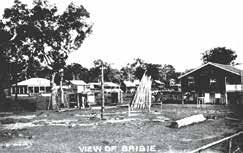
Bowls Club) where Jessie died in May 1944.
BOARDING HOUSE LADIES
Mrs Davies –Running a Boarding House on Bribie In 1921 there were three Boarding Houses on Bribie Island all situated in Banya Street, Bongaree. Running a boarding-house wasn’t easy 100 years ago and the women who welcomed guests, disembarking from the Steamships three times a week, certainly didn’t have the mod-cons we have today. Electricity and mains water didn’t arrive until 1953 and 1961 respectively, so Mrs Bridget Davies of Glan-yMor, like her counterparts in Carlton House (Mrs Davis) and Rosevilla (Mrs Stone) made do with a wood-stove for cooking and tank or bore water for drinking and laundry. No washing machine or dryer and no electric iron to take the creases from the tablecloths and pillow slips. Kerosene lamps or candles lit the houses at night. Glan-y-Mor was a family concern and Bridget was helped by her husband Robert, her twin daughters, Lily and Rose and son Bob.
Glan-y-Mor’s speciality was morning and afternoon teas in the Novelty Garden, clipped from the Bribie Pines. With ice only delivered three times a week on SS Koopa Mrs Davies couldn’t do without local storekeeper Artie Bestmann delivering fresh milk and cream from his little dairy. Lunch and dinner were communal on long tables served in the outdoor, netted dining room - usually fresh fish and oysters. Little market gardens flourished on the island to cater for the salads, veggies and desserts. Glan-y-Mor planted pineapples, a new crop for the district. Guests though welcomed Bridget’s renowned Pea and Ham soup which gave her guests a change from fish dinners. There were no ensuites in the houses as indoor plumbing was not available, so family and guests used bathrooms and outhouses situated in the garden. Each room though would have had a lovely ceramic basin and jug and mirror for a quick wash or shave. All the Boarding-house ladies advertised that visitors could rely on every comfort and attention with superior accommodation and wellkept tables. The houses weren’t large, like the boarding-houses at Sandgate but they were advertised as being able to lodge 18 guests at Glan-y-Mor, 25 at Carlton House and 13 at Rosevilla.
By 1922 Glan-y-Mor leased the Tug Company’s Dining Room and Kiosk at the Jetty and Rose cooked and waitressed in the dining room while her sister Lily helped Bridget run the boarding-house. Bob looked after the campers by selling necessities like tea, milk, butter, bacon, soap etc. from his little dray and arranged sightseeing tours and bush walks around the island. Robert, a keen photographer, made money on the side by selling his photo-postcards of Bribie. By 1953 the twins were the only family left and they returned to live with their sister at Bulimba. They were not forgotten for when the Bribie Bridge opened in 1963 they were honoured guests at the opening celebration.


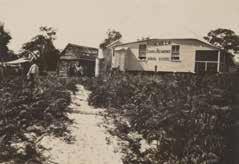


LOU YOUNG’S DEDICATION TO BRIBIE
In the Bribie Island Historical Society’s book “Describing Bribie Island 18651965”, on page 61, is an article called “Lou’s Wartime Bribie” an engaging description of a young girl’s teenage years on Bribie during World War 2. Marguerite Farleigh, called Lou, returned to Bribie in December 1963 with her husband, Ken Young, and their three children to establish the Bribie Welding Works. A busy mum she still found time to become involved with the Bribie State School P&C and became Secretary. A keen bookworm she reorganised the School’s library, purging it of the old tattered books and petitioning the committee for the funds to buy suitable books for the students. A month after the opening of the Bridge in October 1963, the Bribie Island Chamber of Commerce was formed. Many believed the heavy Toll placed on the Bridge would retard Bribie’s growth which had a population of only around 700 at the time. One of the many items on the Chamber of Commerce’s plan for Bribie was a Library. Jack Williams, the local police sergeant, asked Lou if she would be the Librarian if he could get a ‘Council Library going’. On 4th December 1964, the library was established in the old Snack Bar and Toilet Block situated in the park, opposite the Jetty, where the Library is today. Initially, it opened only five hours a week with about 200
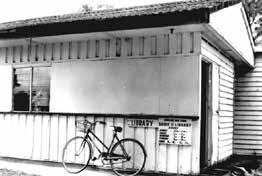
fiction and children’s books and 100 non-fiction able to be borrowed. Eleven years later, in 1976, the old Snack Bar and Toilet Block was demolished to make way for a new Council built library. Lou, without any formal training, continued as Library Assistant-in-Charge until her retirement 27 years later in 1992.
On the eve of her retirement, Lou, not forgetting her P&C background, produced a 34-page document called “A Collection of Information for Students: 1965-1992” which is essentially a manual about Bribie Island. The booklet, still available in the research section of the Library, gives a wonderful snapshot of information about Bribie’s history, flora and fauna, community organisations, businesses, services etc. What a tremendous legacy for generations to come. Lou was also an avid writer of poems, many of which celebrated Bribie and its community, and she won awards from the International Society of Poets. Lou was involved with many Bribie community groups, like the Bribie Island Ambulance Volunteers, and they valued her expertise in fundraising and community awareness drives. Lou’s service to the community was officially recognised by the Caboolture Shire Council and the Bribie Island and Districts Tourism and Activities Association for her dedication to community service.
Lou and Ken retired to Esk where she passed away in September 2010.
EMILY HOWARD COUNGEAU – BRIBIE’S RENOWNED POET
Although Emily had humble beginnings, by the end of her life she was acclaimed as a successful businesswoman, prolific and popular poet and lyricist,

a supporter of her church, her community, and many women’s associations. Emily and Naoum came to Brisbane in 1889 to run a café across from the newly built Customs House in Queen Street. Emily was born in England in 1860 and Naoum Coungeau, an Albanian in 1857. They met in Turkey; where he was working as an attaché to a German general, and 24-year-old Emily as Secretary to an English lady living on the island of Lesbos. They decided on a new life in Australia, first going to Melbourne then on to
Brisbane. By 1915 their simple café was an elegant continental style restaurant and the Coungeau’s commercial success allowed them to become significant patrons of the arts and contributors to worthy causes including World War 1 charities. In her early 50s, Emily began writing poems about the middle-east she knew so well and the ANZAC troops in this war arena. Her very popular poems were published not only in Brisbane magazines and newspapers but in other States as well. Her first book of poems, called Stella Australis, was published in 1914 and proved so popular it went to two editions. In 1912 they had fallen in love with a half-acre block of land in Banya Street, Bongaree, and renowned architects, Hall & Dodds, designed their Queenslander style retirement home. The house was finished in 1916 and they retired to Bribie in 1919 after 30 years working in Brisbane. At that time only about 200 people were living permanently on Bribie and both Emily and Naoum quickly became an integral part of its small community. Emily, a staunch Anglican, wanted a church so she fund-raised money for the building of St Peter’s Hall in Foster Street, giving in 1928, a handsome silky oak altar and hangings. While living on Bribie, Emily still wrote and published her poems in the newspapers and these she collected into three books, with Rustling Leaves published in 1920, Palm Fronds in 1927 and Fern
Leaves in 1934. Emily was friends with the renowned composer Alfred Hill and her drama “Princess Mona” became the libretto for his new Opera called Auster. Auster was performed as a Cantata at Sydney’s Town Hall in 1922 and in 1935, at His Majesty’s Theatre

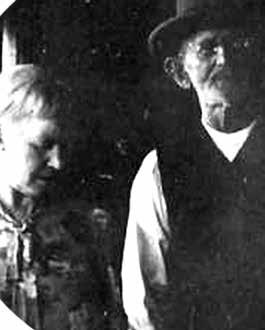
in Melbourne, Auster was billed as ‘the first Australian Opera ever performed by a professional company’. In 1936 they decided to sell their home and sail to England for a holiday, but the depression brought no offers, so they gave their home to the Anglican Church as a holiday-home for the Clergy. They never made their trip as Emily fell ill and in July 1936 she passed away in Brisbane, followed five weeks later by Naoum. He couldn’t live without his wife of over 50 years. Coungeau House was sold by the Anglican Church to the Toc H Organisation in 1969 and is available for use, as a holiday home, by disadvantaged families and not-for-profit organisations.
SARAH BALLS ESTABLISHED THE FIRST BUSINESS ON BRIBIE
Sarah Balls was an extraordinary Brisbane businesswoman but who would have imagined that she would build a fish cannery on Bribie Island in 1908. Sarah found her talent for management in Ipswich when her husband was running the Queensland Hotel in 1893. John Balls went off to the goldfields in 1895 handing over the Hotel to her which she managed as well as looking after their four children. Three years later, after his death in the Kalgoorlie goldfields, Sarah went first to Maryborough where she leased the Queens Hotel then to Brisbane where she leased the Stock Exchange Hotel in Queen Street. Hotels then couldn’t sell alcohol on Sunday, so Sarah leased the Brisbane Central Station Cafe from the Government as it allowed her to sell alcohol as long as the trains were running and at Central
Station that was nearly 24/7. Within three years Sarah was leasing thirteen more railway cafes and all were successful as she handpicked her managers. In 1907, aged 45, Sarah turned her attention to the new Federal Bounty Act which was presenting opportunities in manufacturing. With no fish market in Brisbane at the time, she thought that canning fish from Moreton Bay was a great prospect. By the next year, she had leased eight acres of land on Bribie, just north of the Bongaree IGA, and set up her factory which was capable of handling nearly 10 tons of fish a week. 20 people, were employed turning out 200 cases with each case containing 4 dozen tins of mullet, snapper, tailor etc. Local fishing families were paid £150 for the season. With no local ice works, Pumicestone fishermen couldn’t take their catches to Brisbane, so the new
cannery was a godsend. Sarah first brought an expert from Scotland and put him in charge of the venture. The cannery in the early days lacked a refrigerator/freezer and after tons of fish were dumped by fishermen on the cannery wharf, some of the fish wasn’t quite fresh enough for canning and many tins “blew”, and Sarah’s Diver brand got a bad name. Sarah then took over, putting local fisherman, Ted Crouch, in charge of the factory and decided to only can from April to August. Sarah received the nickname of ‘Mum Balls’ for her hands-on approach to the business and won the locals respect. The Bounty period finished after five years and by 1914 the canning works weren’t as profitable so she sold the business. Cheaper imports had flooded the market and though she was also canning asparagus and pineapple a lack of tin, due to WW1, caused production problems. The Cannery still was giving seasonal employment to many locals up to 1922 then the factory and lease were sold to J.E. Burnard & Co, Jam Manufacturers and Fruit Preservers. All the equipment was moved to Brisbane leaving only the Jetty which became a favourite fishing spot. In 1915 Sarah’s son John had been injured at Gallipoli and she sailed to England to nurse him. In 1917 the Government found that Sarah was making too much profit with her Railway Cafes and took back control of the leases. There were many complaints that the service and refreshments were not like they were in Sarah’s time. Sarah, when she retired, was a very wealthy woman. Sarah, travelled to the United States in 1926 and fell in love with the modern Hacienda/Mission style houses and built her dream home “Santa Barbara” in New Farm. The house, an architectural gem, was featured in many magazines of the time. Sarah died in 1932 and was remembered as Brisbane’s most successful businesswoman.
